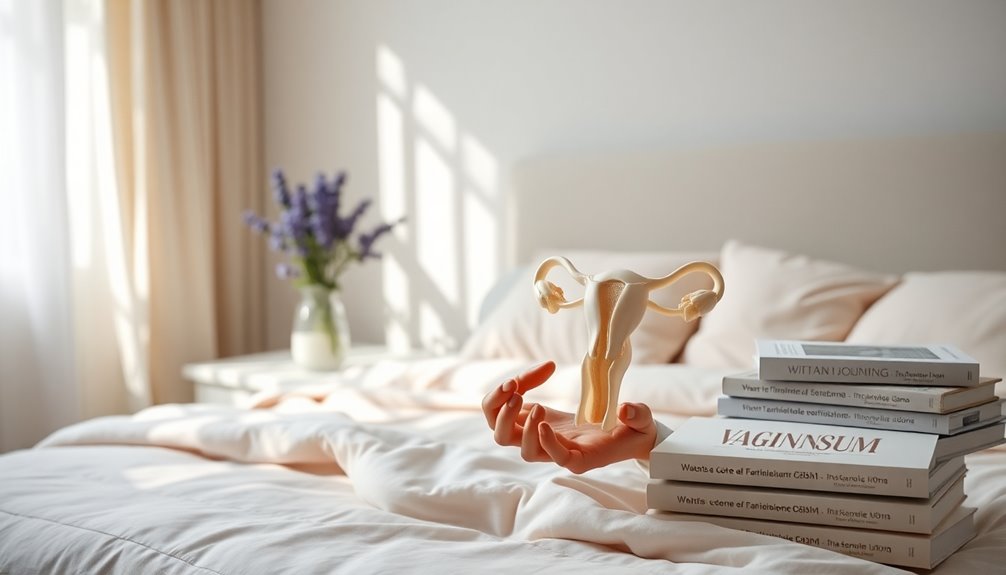Vaginismus is a painful condition where your vaginal muscles involuntarily contract, making penetration during sex or medical exams difficult or even impossible. It affects 1-7% of women worldwide and can leave you feeling isolated and anxious. Symptoms range from discomfort to intense pain, often linked to psychological factors. Fortunately, there are effective treatment options available. If you're curious about how to manage this condition and the potential paths to recovery, there's so much more to explore.
Key Takeaways
- Vaginismus is an involuntary contraction of vaginal muscles, causing pain or inability to engage in penetration during sexual activities or medical exams.
- It affects 1-7% of women globally, often exacerbated by cultural taboos and psychological factors such as anxiety and fear.
- Symptoms include pain during penetration and a sensation of a "brick wall" at the vaginal entrance, impacting sexual health and relationships.
- Treatment options include vaginal dilators, pelvic floor physical therapy, and cognitive behavioral therapy to address anxiety and trauma.
- Psychological factors play a significant role, and emotional distress from vaginismus can lead to isolation and damaged personal connections.
Understanding Vaginismus

Understanding vaginismus can be challenging, especially since it often goes unspoken. This condition involves the involuntary contraction of vaginal muscles, making penetration during sexual activities or medical examinations painful or even impossible.
Depending on its severity, you might experience anything from mild discomfort to intense pain, often leading to avoidance of intimate relationships. Vaginismus is increasingly recognized as part of genitopelvic pain/penetration disorder (GPPPD), which encompasses both vaginismus and dyspareunia.
Vaginismus can cause discomfort to pain, often leading to the avoidance of intimate relationships.
Fortunately, effective treatment options exist. You can explore pelvic floor physical therapy, cognitive behavioral therapy, and vaginal dilators, which have shown success rates as high as 90% in specialized centers. Additionally, addressing unresolved issues related to intimacy can significantly aid in overcoming this condition.
Recognizing and addressing vaginismus is vital for restoring intimacy and improving your quality of life.
Prevalence of Vaginismus

When it comes to vaginismus, you might be surprised to learn that it affects around 1-7% of women globally, but this number could be much higher due to underreporting.
Many women don't seek help because of societal shame and a lack of awareness about sexual health issues. Awareness of narcissistic behaviors is essential in recognizing the true prevalence of vaginismus. Understanding these factors is essential in recognizing the true prevalence of vaginismus.
Global Prevalence Rates
Globally, vaginismus affects about 1-7% of women, although cultural taboos often lead to underreporting. Reports from sexual health clinics suggest that prevalence may range from 5% to 17%, indicating a significant issue in reproductive health. A 2020 study found that 82% of Indian women face sexual difficulties, hinting that vaginismus might be more widespread than recognized. Understanding the emotional instability associated with vaginismus can help improve support and treatment options for those affected.
| Region | Estimated Prevalence | Notes |
|---|---|---|
| Global | 1-7% | Cultural influences affect data |
| Clinics | 5-17% | Common psychosexual dysfunction |
| India | Possibly higher | 82% face sexual difficulties |
Encouraging discussions with healthcare providers about vaginismus can help mitigate underreporting and improve awareness.
Underreporting Factors
Vaginismus often goes unreported, and this underreporting stems from several interrelated factors. Cultural taboos surrounding sexual health play a significant role, especially in countries like India, where many women face shame when discussing their symptoms.
With prevalence rates estimated between 5% to 17%, vaginismus is one of the most common psychosexual disorders among women, yet the exact figures remain elusive due to stigma and a lack of thorough studies. Many women may feel embarrassed, leading to a lack of awareness and diagnosis. Increasing education and awareness about vaginismus can empower individuals to seek help, ultimately helping to reduce underreporting and improve understanding of this condition within the broader context of sexual health. Additionally, understanding the importance of awareness regarding similar health issues can further encourage open discussions about vaginismus.
Symptoms of Vaginismus

If you're experiencing pain during penetration, it might be a sign of vaginismus.
This condition often involves involuntary muscle contractions that make any attempt at vaginal insertion uncomfortable or impossible.
Understanding these symptoms can help you identify and address the issue more effectively. Emotional dysregulation is a key factor that can exacerbate the experience of vaginismus.
Pain During Penetration
Experiencing pain during penetration can be distressing and isolating, especially when it stems from involuntary muscle contractions that characterize vaginismus. This medical condition often leads to vaginal pain during sex, making intimacy feel impossible.
Many individuals report a sensation of a "brick wall" at the vaginal entrance, intensifying the discomfort. This pain isn't limited to sexual encounters; it can also occur during gynecological exams, causing anxiety and reluctance to seek necessary medical care.
The fear of pain related to penetration may be tied to past sexual trauma, creating a cycle of avoidance. The severity of symptoms varies, with some facing debilitating pain that greatly impacts their sexual health and overall quality of life. Addressing underlying issues, such as emotional distress and insecurity, is crucial for individuals experiencing vaginismus.
Involuntary Muscle Contraction
When faced with involuntary muscle contractions, many individuals find that even the thought of penetration can trigger anxiety and discomfort.
Vaginismus causes your pelvic floor muscles to involuntarily contract around the vaginal entrance, making sexual intercourse feel impossible. You might experience muscle tension that ranges from mild discomfort to severe pain, even if you've had painless penetration before.
This response is often fueled by psychological factors, such as fear of pain or past trauma, leading to avoidance of intimate moments. As these contractions occur, they can create a sensation akin to a "brick wall," intensifying feelings of distress and affecting your overall well-being and relationships. Understanding this can help you address and manage these challenging symptoms. Additionally, seeking professional counseling can provide valuable support in overcoming the emotional aspects related to vaginismus.
Causes of Vaginismus

Understanding the causes of vaginismus is crucial, as it often stems from a mix of physical and psychological factors. These may lead to significant physical discomfort and negative feelings around intimacy.
Some common causes include:
- Anxiety or fear related to penetration
- Past traumatic experiences affecting sexual health
- Cultural taboos and lack of sexual education
- Physical conditions like infections or anatomical abnormalities
These psychological factors can make your body perceive penetration as a threat, triggering involuntary muscle contractions.
Additionally, a history of painful sexual experiences can worsen the condition. Recognizing these causes is essential for successful treatment, as addressing both physical and emotional aspects can lead to improved intimacy and overall well-being. Furthermore, emotional neglect can exacerbate feelings of anxiety, making it even more challenging to seek help for vaginismus.
Diagnosis and Tests

Addressing vaginismus starts with a thorough diagnosis that involves discussing your symptoms and medical history with a healthcare provider.
They'll focus on the involuntary muscle spasms you experience during attempts at penetration. A pelvic exam may be conducted to confirm these muscle spasms and rule out other potential medical issues.
If you're feeling anxious about discomfort, topical numbing creams can be used during the exam to ease your experience.
An accurate diagnosis is essential, as it requires that symptoms be present for at least six months and aren't attributed to other disorders, relationship distress, or substance use.
This process helps differentiate vaginismus from similar conditions like dyspareunia or pelvic floor dysfunction, ensuring you receive the appropriate care.
Treatment Options for Vaginismus

Effective treatment options for vaginismus often combine physical and psychological strategies to guarantee a holistic approach. Many individuals find success with a multidisciplinary plan that includes:
- Vaginal dilators to gradually acclimate to penetration
- Pelvic floor physical therapy targeting muscle relaxation and control
- Cognitive behavioral therapy (CBT) to address anxiety and trauma
- Education on sexual health to foster open communication
Specialized centers report around a 90% success rate with these individualized treatment plans.
Topical numbing agents can ease discomfort during initial phases, enhancing your comfort and confidence. Additionally, maintaining skin hydration is crucial for overall comfort and wellness during treatment.
The Role of Psychological Factors

When you experience vaginismus, psychological factors like anxiety and fear can play a significant role in your symptoms.
Past traumatic experiences and negative beliefs about sexuality can heighten your discomfort and create a cycle of tension and pain.
Understanding these connections is essential for addressing the condition effectively. Additionally, emotional and psychological growth influences an individual's ability to cope with such conditions over time.
Anxiety and Fear Responses
Anxiety and fear responses play a pivotal role in the experience of vaginismus, as they can trigger involuntary muscle contractions that make penetration feel threatening.
This heightened tension in your pelvic floor muscles can lead to discomfort and pain, reinforcing negative feelings about intimacy.
Consider these key factors:
- Anxiety surrounding sexual intimacy
- Involuntary muscle contractions during attempts at penetration
- The disconnection from your pelvic floor muscles
- The importance of mental health support
Addressing these psychological factors is essential.
Seeking help through cognitive behavioral therapy (CBT) can effectively reduce anxiety, allowing for a more positive approach to intimacy and enhancing your overall sexual experience.
Traumatic Experiences Impact
Traumatic experiences can profoundly impact your relationship with intimacy, often leading to the development of vaginismus. Events like sexual abuse or painful medical examinations can create a strong link between penetration and feelings of fear or pain.
Consequently, your body may react with involuntary muscle contractions, perceiving penetration as a threat. Heightened anxiety surrounding sexual activities can exacerbate vaginismus symptoms, making it even harder to relax during attempts at intimacy.
Disconnection from your pelvic floor muscles complicates this further, as past trauma influences your ability to engage fully. Seeking mental health support is essential in addressing these psychological factors, as it can improve your treatment outcomes and help reduce symptoms associated with trauma.
Beliefs About Sexuality
Beliefs about sexuality can shape your experiences with intimacy, often leading to feelings of shame or fear surrounding penetration. These beliefs can trigger anxiety that affects your pelvic floor muscles, resulting in discomfort.
Consider these factors:
- Negative associations with sexual intimacy
- Involuntary muscle tension during penetration attempts
- Lack of knowledge about sexual health
- Past traumatic experiences
When anxiety ties to penetration, your body may react defensively, causing contractions that reinforce vaginismus.
Seeking mental health support is essential, as therapy can help you address these underlying beliefs and anxieties about sexuality. By understanding and reframing your beliefs, you can work towards overcoming these challenges and improving your intimate experiences.
Living With Vaginismus

Living with vaginismus can be challenging, as it often leads to emotional distress that affects your relationships and self-esteem.
You might experience anxiety or fear around sexual activities, making penetration feel intimidating. This fear can lead to avoidance of intimacy, which may damage personal connections and amplify feelings of isolation.
Many people with vaginismus feel embarrassed, hindering open discussions about their struggles. However, treatment options like pelvic floor physical therapy can provide effective strategies to manage your symptoms.
Patience is key on this journey; while recovery may take time, many individuals report significant improvements in their sexual health and overall well-being after seeking help.
At-Home Treatment Strategies

If you're looking for ways to manage vaginismus from the comfort of your home, several effective strategies can help. Consider incorporating these approaches into your routine:
- Dilator therapy to gradually acclimate your vaginal muscles to penetration.
- Breathing techniques to reduce anxiety and tension during attempts to insert a tampon or engage in penetration.
- Self-assessment guides to identify your triggers and tailor your management plan.
- Virtual pelvic floor physical therapy for personalized support and exercises to enhance relaxation.
Consistent practice of these techniques can improve your comfort levels and ease symptoms.
Seeking Professional Help

When experiencing vaginismus, seeking professional help is essential, as early intervention can lead to better treatment outcomes.
Healthcare practitioners, like gynecologists and pelvic floor physical therapists, can provide accurate diagnoses and personalized treatment plans. They address the physical and psychological factors contributing to your symptoms.
Healthcare professionals, including gynecologists and pelvic floor therapists, offer tailored diagnoses and treatment plans addressing both physical and emotional aspects of vaginismus.
Specialized therapy options, such as cognitive behavioral therapy (CBT) and sex therapy, can effectively manage the anxiety and emotional distress linked to vaginismus.
If you're more comfortable at home, consider virtual pelvic floor physical therapy, which offers guidance and support remotely.
Remember, supportive environments like sexual health clinics encourage open discussions, reducing the stigma and shame often felt when seeking help.
Take that step; your well-being matters!
Frequently Asked Questions
Can Vaginismus Occur in Women of All Ages?
Yes, vaginismus can occur in women of all ages.
It's not limited to any specific age group or life stage. Whether you're a teenager, an adult, or even post-menopausal, you can experience this condition.
Factors like anxiety, trauma, or hormonal changes can contribute to its development.
If you're facing this issue, know that you're not alone, and seeking help from a healthcare professional can provide you with the support you need.
Is Vaginismus a Permanent Condition?
Vaginismus isn't necessarily a permanent condition. Many women experience it temporarily, often linked to specific stressors or experiences.
With the right approach, including therapy and relaxation techniques, you can manage and overcome it. It's important to communicate openly with healthcare professionals who can guide you through effective treatment options.
How Can Partners Support Someone With Vaginismus?
To support someone with vaginismus, you should communicate openly and patiently.
Encourage them to express their feelings and fears without judgment. Create a safe environment where they feel comfortable discussing their experiences.
Participate in relaxation techniques together, like deep breathing or gentle massages. Educate yourselves about the condition, and consider seeking professional help together.
Your understanding and reassurance can make a significant difference in their journey toward healing and intimacy.
Are There Lifestyle Changes That Can Help Reduce Vaginismus Symptoms?
Around 10-20% of women experience vaginismus at some point in their lives.
To reduce its symptoms, you can focus on lifestyle changes like practicing relaxation techniques, such as yoga or meditation, which help ease tension.
Regular pelvic floor exercises may also strengthen your muscles and improve control.
Additionally, maintaining open communication with your partner about your feelings and experiences can create a supportive environment that fosters healing and understanding.
What Misconceptions Exist About Vaginismus?
There are several misconceptions about vaginismus that can lead to confusion.
Many people think it's purely psychological, ignoring the physical aspect. Others believe it's rare, but it affects a significant number of individuals.
Some assume it only happens during intercourse, while it can occur with any vaginal penetration.
You might also hear that it's a result of a lack of arousal, but it's often more complex than that, involving both physical and emotional factors.
Conclusion
In a world where intimacy can feel like a locked door, understanding vaginismus opens the path to healing. You're not alone in this journey; many face similar struggles. By exploring treatment options and seeking support, you can reclaim your comfort and confidence. Remember, every step forward is a victory—don't hesitate to reach out for help. Embrace your journey toward intimacy, and soon, you'll find that door swings wide open.









